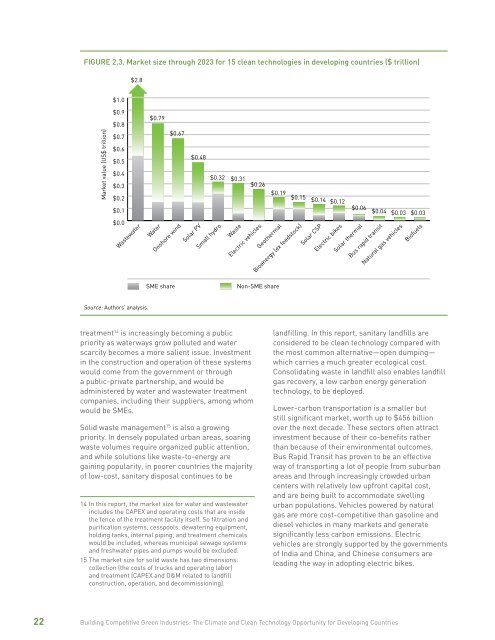Building Competitive Green Industries
green-industries
green-industries
Create successful ePaper yourself
Turn your PDF publications into a flip-book with our unique Google optimized e-Paper software.
FIGURE 2.3. Market size through 2023 for 15 clean technologies in developing countries ($ trillion)$2.8$1.0Market value (US$ trillion)$0.9$0.8$0.7$0.6$0.5$0.4$0.3$0.2$0.79$0.67$0.48$0.1$0.0WastewaterWaterOnshore windSolar PVSmall hydroWasteElectric vehiclesGeothermalBioenergy (ex feedstock)$0.32 $0.31$0.26$0.19 $0.15 $0.14 $0.12$0.06 $0.04 $0.03 $0.03Solar CSPElectric bikesSolar thermalBus rapid transitNatural gas vehiclesBiofuelsSME shareNon-SME shareSource: Authors’ analysis.treatment 14 is increasingly becoming a publicpriority as waterways grow polluted and waterscarcity becomes a more salient issue. Investmentin the construction and operation of these systemswould come from the government or througha public-private partnership, and would beadministered by water and wastewater treatmentcompanies, including their suppliers, among whomwould be SMEs.Solid waste management 15 is also a growingpriority. In densely populated urban areas, soaringwaste volumes require organized public attention,and while solutions like waste-to-energy aregaining popularity, in poorer countries the majorityof low-cost, sanitary disposal continues to be14 In this report, the market size for water and wastewaterincludes the CAPEX and operating costs that are insidethe fence of the treatment facility itself. So filtration andpurification systems, cesspools, dewatering equipment,holding tanks, internal piping, and treatment chemicalswould be included, whereas municipal sewage systemsand freshwater pipes and pumps would be excluded.15 The market size for solid waste has two dimensions:collection (the costs of trucks and operating labor)and treatment (CAPEX and O&M related to landfillconstruction, operation, and decommissioning).landfilling. In this report, sanitary landfills areconsidered to be clean technology compared withthe most common alternative—open dumping—which carries a much greater ecological cost.Consolidating waste in landfill also enables landfillgas recovery, a low carbon energy generationtechnology, to be deployed.Lower-carbon transportation is a smaller butstill significant market, worth up to $456 billionover the next decade. These sectors often attractinvestment because of their co-benefits ratherthan because of their environmental outcomes.Bus Rapid Transit has proven to be an effectiveway of transporting a lot of people from suburbanareas and through increasingly crowded urbancenters with relatively low upfront capital cost,and are being built to accommodate swellingurban populations. Vehicles powered by naturalgas are more cost-competitive than gasoline anddiesel vehicles in many markets and generatesignificantly less carbon emissions. Electricvehicles are strongly supported by the governmentsof India and China, and Chinese consumers areleading the way in adopting electric bikes.22 <strong>Building</strong> <strong>Competitive</strong> <strong>Green</strong> <strong>Industries</strong>: The Climate and Clean Technology Opportunity for Developing Countries


